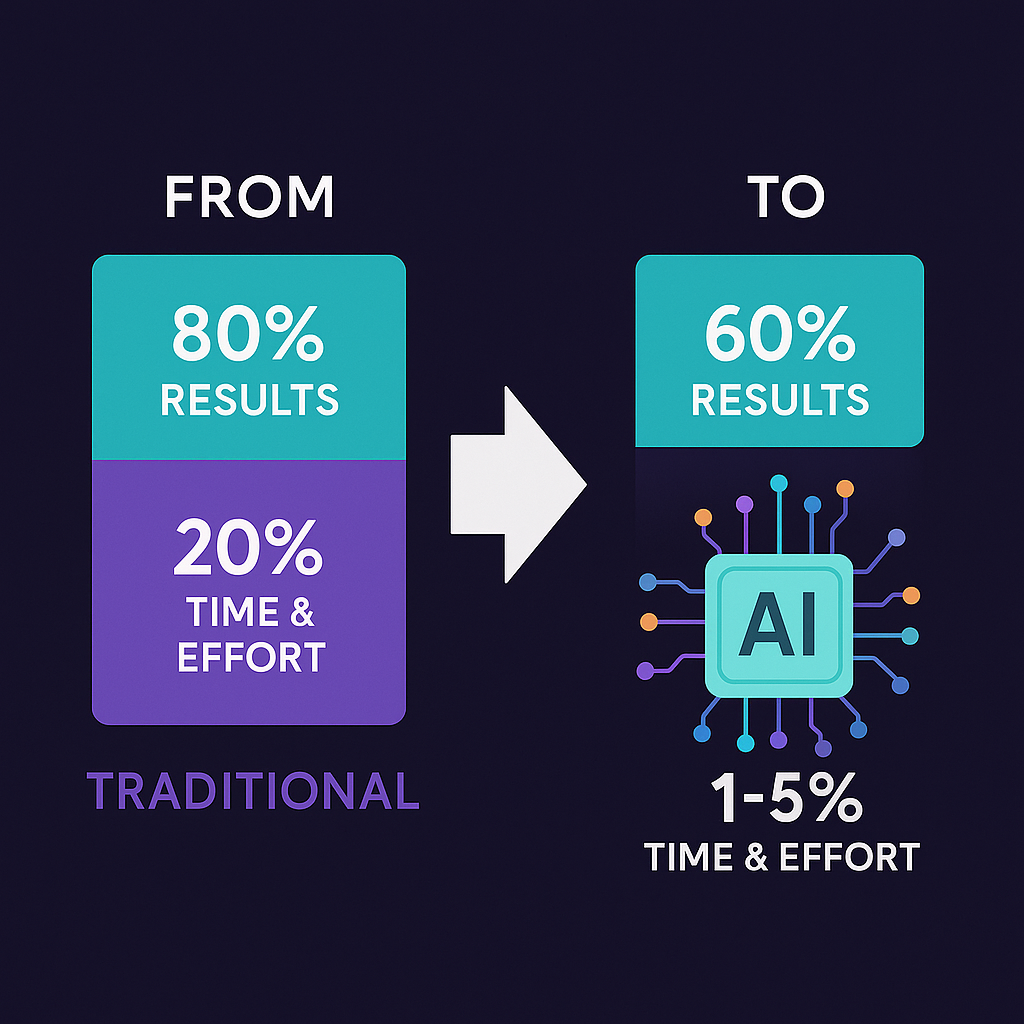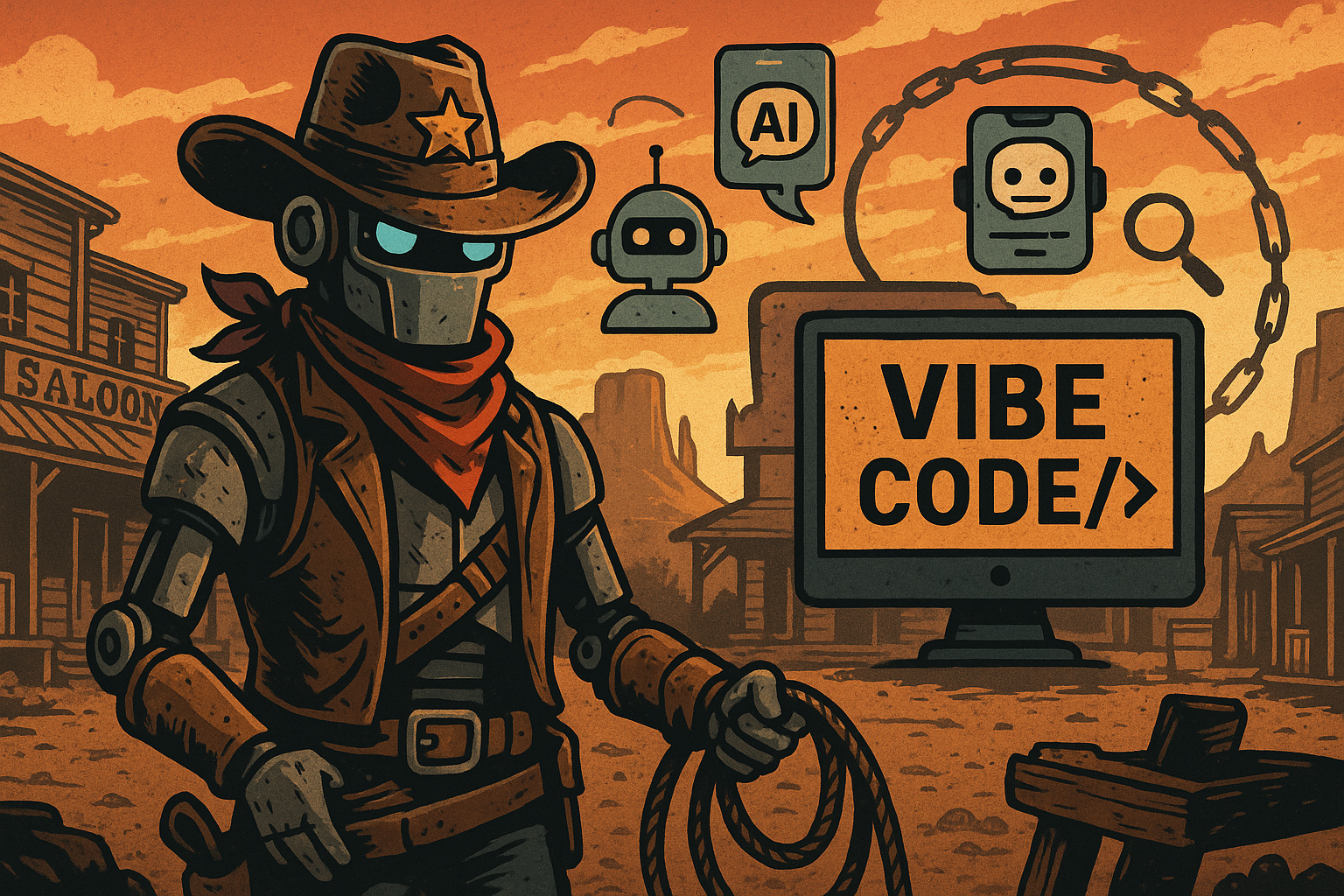Vibe WHAT?!
Vibe coding might sound like Gen Z slang, but it’s a real—and important—shift in how software is made. Vibe coding is an AI-powered approach to creating apps, both mobile and web, simply by having a conversation with an AI. Forget about generating just a few lines of code. With vibe coding, you can build complete applications just by describing your vision. And now, with “vibe designing,” you can even create user interfaces via natural language prompts.
We’re talking about turning ideas into real apps or designs in minutes or hours, not days or weeks. Let that sink in for a moment.. Yes you really can build more, faster with AI!
From Pareto to Exponential Productivity
Traditionally, the Pareto Principle tells us that the bulk of results comes from a small portion of the effort. But with vibe coding and vibe designing, the game has changed. Now, you can accomplish 60% of the work in just 1–5% of the time—a shift that has profound consequences for productivity and innovation.

Hype or Reality?
You might be skeptical. “Haven’t we heard this before?” Over the past years, new automation technologies—low-code, no-code—have promised to make software development accessible to everyone and, perhaps, to make developers obsolete. Honestly, I have also been on this side of the debate oftentimes.
So, where does vibe coding fit in? Is it just hype, or is there more to it? After experimenting with multiple vibe coding tools, I’ve seen both impressive results and frustrating limitations. I feel like I can now point out its strengths and weaknesses—and how you can use them.
The Good
To put it bluntly, vibe coding is FREAKING AWESOME. The ability to see your vision come to life with a few text prompts is absolutely magical. Product Managers and Innovators can relate to this feeling of seeing the design of your idea for the first time.
Speed
Now take this feeling but remove the time lag from having an idea, putting it on paper, giving it to a designer or developer, and seeing the results. Its speed is absolutely unparalleled. I don’t have to tell you how this will improve the rate of innovation and testing in your organization—you figured that out immediately.
Versatility
Another thing that impressed me is the number of tools and the support for different types of applications. You can create websites, apps, and web applications. You can create them in Python, React (Native), Rust, Kotlin, Angular, NextJS, and many more coding languages. This creates flexibility. If your software developers are mostly skilled at React, well, go for React!
The Bad
Is it all rainbows and unicorns? No, definitely not! Getting your first 60% done can be really fast, but after that comes the struggle. You wanted that icon to be in a different position? Problematic! You wanted to change a few things without destroying half of the app? Impossible!
These apps are great to get started, but as soon as you want to move from 60% to 90–100%, you will encounter a world of struggle. Making changes will introduce problems in other places, just like real-world programming. A lot of vibe coding tools can solve these problems, but you will come to realize that they lack refinement after they need to solve the same problem for the 10th time.
The Ugly
Cowboy vibes
The universe of vibe coding is a wild west of tools, influencers, and outdated information. New tools appear regularly, often without clear instructions and documentation, making it hard to understand their capabilities. These tools grow by paying affiliates to influencers who will show off the “greatness” of the tool with very basic examples.
Getting stuck inside a loop with a problem your vibe tool doesn’t understand? Good luck—there is no way you can “Google” or “ChatGPT” yourself out of that one. And customer service? Not sure what that is, sir…

Incomplete features
Some tools can lure you in with great initial results. You invest your time in refining these results, only to come to the conclusion that the tool does not yet support database integrations or automatic publishing. Not a problem if you are a software developer, but as a non-coder, you have just spent a few hours for nothing.
Opaque pricing
Pricing can be obscure and hard to evaluate. For example, 20 dollars a month gives you 10 million tokens with Bolt. But you have no idea what you can do with those 10 million tokens. With some apps, you will run through your monthly limit in a matter of hours; others will last you longer without clear reasoning why. In some cases, you will get the job done only to find out that to publish your app you will need to pay more.
The Verdict
So, how do these things add up? Vibe coding tools are amazing. It is a new development, and I am sure a lot of my struggles and criticisms will be solved within the next few months.
Do I think it will replace the need for software developers? Not entirely. Will software developers become more productive? Sure! While vibe coding accelerates some aspects of software creation, the need for human insight hasn’t disappeared. At this point, you can only create very basic results without needing a developer. If you want to create complex solutions, vibe coding can help you prototype and test ideas, but it is not ready to create these solutions yet.
And even for simple solutions, this is not the whole picture. You still need to validate ideas, ensure user needs are met, and make strategic decisions. AI is your accelerator, not your autopilot.
Whether you’re an entrepreneur, a product owner, an innovation manager, or a software developer, this shift will impact how you work:
- Speed to Market: You can bring new products and features to market faster than ever before.
- Experimentation: It becomes easier (and cheaper) to test new ideas, pivot, and iterate.
- Democratization: The barrier to entry for app development is dropping. You don’t need to be a seasoned developer to build real products.
- Collaboration: Teams can focus more on vision and strategy, and less on the technical grind.
Conclusion
AI-driven approaches like vibe coding and vibe designing are rewriting the rules of productivity in software development. If you’re not already exploring these tools, now is the time. The next wave of innovation won’t just be faster—it will be more accessible, creative, and transformative.
Do you face challenges in your work environment? Are you walking around with a great idea for an innovation? Contact us! Together we will create a first prototype within the day, helping you take the next step.







